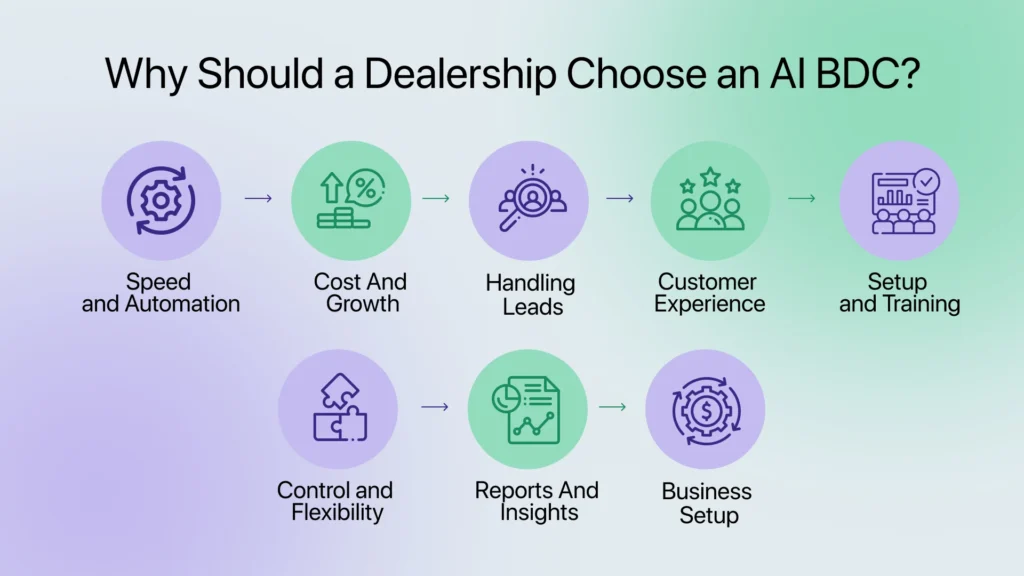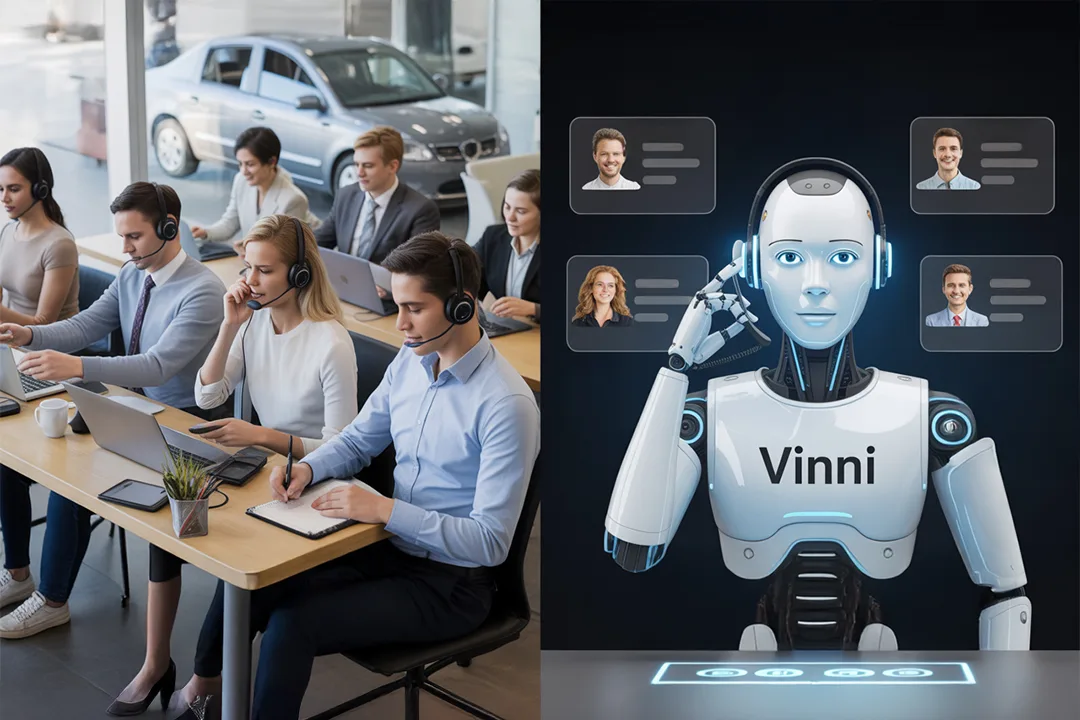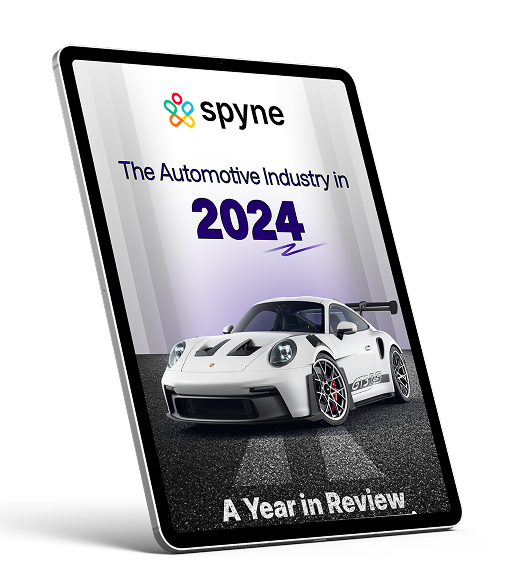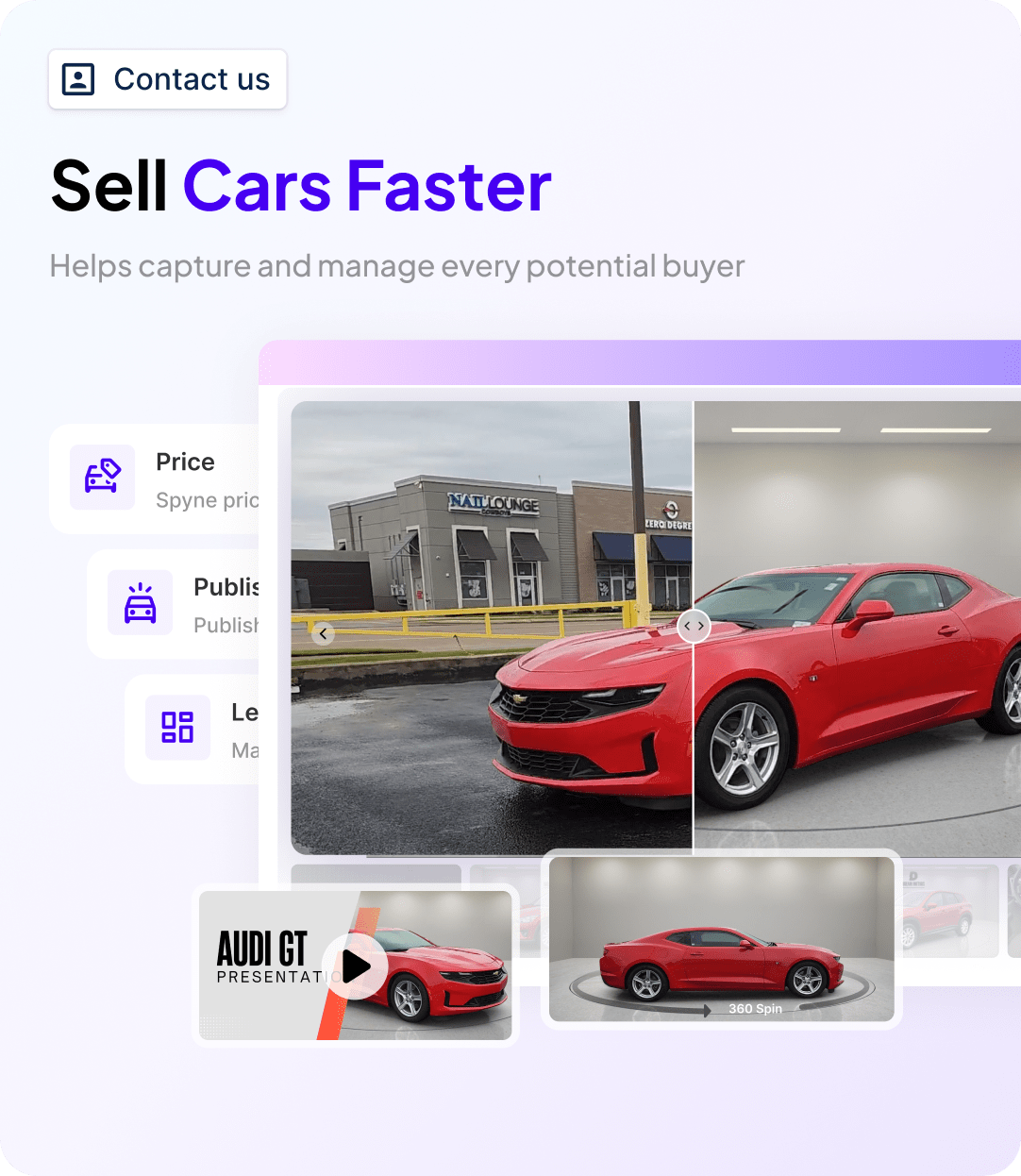How dealerships handle leads is changing quickly: 85% of car shoppers anticipate a response in the initial 10 minutes of contact. This trend has initiated the growth of AI BDC for automobile dealerships, transforming sales and service teams. With increasing BDC auto trends towards automation, the AI BDC vs in-house BDC question is more pertinent than ever. From handling late-night inquiries to measuring operations without added staff, AI is transforming dealership communication. In this blog, we’ll break down the AI BDC vs in-house BDC comparison, with real-world BDC examples and insights every dealer should know.
What is BDC for Car Dealership?
A BDC (Business Development Center) for a car dealership is a dedicated team inside a dealership that handles customer communication, mainly phone calls, texts, emails, and chats. They manage both inbound and outbound messages for the sales and service departments. In a dealership setting, the BDC works to answer customer questions, follow up with leads, schedule appointments, and push buyers further down the sales funnel. Since sales staff are often busy with in-store customers, a BDC ensures no lead or service request slips through the cracks.
Today, many dealers are shifting to virtual BDC models or using AI BDC platforms to handle these tasks faster and around the clock. With growing BDC automotive trends, it’s clear that having a BDC, whether human or tech-powered, improves response time, lead handling, and overall efficiency. Choosing between a traditional or automated model depends on your dealership’s needs, but understanding this role is key to evaluating AI BDC vs In-House BDC properly.
What is in AI BDC
An AI BDC is a modern upgrade to the traditional BDC model used by car dealerships. Instead of relying completely on human reps, it uses automation, chatbots, and machine learning to handle customer interactions like responding to leads, booking appointments, and sending follow-ups.
These AI-powered systems work across channels text, email, live chat, and even voice calls. They connect directly with your dealership’s CRM to make sure every lead is engaged quickly and consistently without any wait time. The goal is to boost response time, eliminate missed opportunities, and let your sales team focus on closing more deals.
In short, an AI BDC acts like a smart virtual assistant for your dealership, working 24/7 to manage leads, schedule calls, and streamline communication. It’s become a key part of today’s BDC automotive trends, especially for dealers looking to scale without hiring more human staff. Understanding how it compares to traditional models is important when weighing AI BDC vs In-House BDC for your dealership strategy.
Why Dealerships Use AI BDC
Car dealerships are embracing AI BDC solutions to simplify operations, respond faster to leads, and drive more sales. This shift reflects ongoing BDC automotive trends, where automation is reshaping how dealerships handle customer communication, and how automotive BDC companies are redefining the way lead management is delivered across the industry.
1. Enhanced Efficiency and 24/7 Availability
An AI BDC handles a high volume of inbound and outbound messages without human supervision. Whether it’s midnight or a weekend, leads are instantly engaged. Compared to traditional models, AI BDC vs In-House BDC clearly shows a major efficiency gain.
2. Faster Response, Smarter Follow-Ups
Speed matters in automotive sales. AI tools respond to leads within seconds, qualify them using smart algorithms, and update your CRM in real time. This smarter use of BDC time leads to better engagement and higher conversion rates.
3. More Appointments, Less Manual Work
AI can book test drives and consultations automatically, no staff needed. This smooth process helps boost appointments and takes pressure off your in-house team. Many virtual BDC automotive setups rely on this automation to keep calendars full, making the outsourced BDC benefits even more appealing for dealerships looking to reduce manual workloads and increase efficiency.
4. Reduced Costs, Increased ROI
By automating repetitive tasks, dealerships cut down on labor costs while improving overall productivity. The ROI of AI-powered systems is often higher than traditional BDC models, making the AI BDC vs In-House BDC decision easier for cost-conscious dealers.
5. Better Customer Experience
With fast, consistent replies and personalized follow-ups, customers enjoy smoother communication across chat, email, text, or phone. As BDC AI tools learn from each interaction, they continue to improve, leading to more satisfied buyers.
6. A Modern Shift in Dealership Communication
From BDC-explained tools to real-time lead handling, the role of BDCs is changing. Whether you’re reviewing BDC comparison charts or reading the latest BDC review, it’s clear that AI is leading the next generation of customer engagement.
What Is an In-House BDC?
An in-dealership BDC (Business Development Center) is an internally built and controlled team of people. It is charged with managing all customer communication, both incoming and outgoing, from lead handling through appointment setting, and serves as a central point of interfacing the sales and service departments. In the context of an automotive BDC, this model depends on actual people operating from within the dealership, and hiring, training, and maintaining them can be time-consuming. Dealers often seek phone sales or customer service experience when filling these positions, but searching for those with suitable skills locally can prove difficult.
In addition, establishing an in-house BDC entails shouldering the entire expense of salaries, benefits, and management overhead. Even though this setup offers more direct control and flexibility, it also demands significant time, effort, and resources. While some dealerships still favor the traditional model for its hands-on involvement, many are now comparing it to more scalable solutions like automotive call center services powered by AI. This shift has intensified the AI BDC vs in-house BDC debate as dealers evaluate the long-term benefits of automation over legacy team structures.
AI BDC vs In-House BDC: Which Lead Management Approach Works Best for Car Dealerships?
Deciding between an AI BDC vs in-house BDC can directly impact how your car dealership manages leads, responds to inquiries, and ultimately sells vehicles. With the rise of automation in the auto industry, many dealerships are rethinking traditional business development centers. A modern AI BDC for car dealerships offers 24/7 lead response, CRM integration, and smart follow-ups, unlike in-house teams that rely on manual tasks and fixed working hours. Here’s a side-by-side comparison of AI BDC vs in-house BDC to help you choose the right fit for your sales and service goals.
| Feature/Factor | AI BDC | In-House BDC |
| Setup & Onboarding | Quick and ready to use; minimal setup required | Requires hiring, training, and setup time |
| Operating Hours | 24/7 lead handling, even after hours | Limited to staff availability and working hours |
| Response Tim | Instant replies via automation | Slower, depends on team availability |
| Lead Qualification | Automated and consistent | Manual can vary by rep |
| Scalability | Easily scales without hiring more staff | Scaling requires recruiting and training |
| Cost | Lower labor costs; fixed software fees | Higher due to salaries, benefits, and overhead |
| Control & Personalization | Less human touch; AI-driven interactions | Full control over training and messaging |
| Consistency | Always follows scripts and logic | May vary depending on agent experience |
| CRM Integration | Seamless and automatic | Manual updates or dependent on team’s accuracy |
| Best For | Dealerships want speed, cost-efficiency, and 24/7 coverage | Dealerships want more human interaction and control |
Why Should a Dealership Choose an AI BDC?
Choosing between an AI BDC vs in-house BDC can be tough. Both options help your dealership talk to customers, handle leads, and book appointments. But they work in different ways. An AI BDC for car dealerships uses technology to do the job automatically, while an in-house BDC is a team of real people inside your dealership. Let’s look at the key differences to help you decide what works best for you.
1. Speed and Automation
An AI BDC replies to customers instantly, even late at night. It never takes a break. But an in-house BDC depends on people, so it can only work during business hours. Today’s BDC automotive trends show that speed really matters in closing deals.
2. Cost and Growth
AI BDCs are cheaper to run. You don’t need to hire or train staff. If your dealership grows, you can easily handle more leads. With an in-house BDC, you’ll spend more on salaries, tools, and training. Many BDC reviews show AI is more affordable as you scale.
3. Handling Leads
AI BDC tools follow up with every lead automatically and never miss a step. But with in-house teams, things can get busy, and leads might be forgotten. Smart tools based on BDC AI know which customers to contact first and when.
4. Customer Experience
People like fast replies. AI BDCs are great at quick responses across chat, text, and email. But some customers prefer talking to a real person. In-house BDCs offer a human touch, which matters for building trust. Some dealers use both a virtual BDC automotive setup to balance speed and service.

5. Setup and Training
You can set up an AI BDC in days. It’s ready to go fast. But an in-house BDC takes weeks to hire and train. Think about BDC time, how much time it takes to get your team ready to talk to leads properly.
6. Control and Flexibility
If you want more control over what your team says and how they work, an in-house BDC is a good choice. But it also means more management. A virtual BDC with automation lets you stay flexible without having to manage a big team.
7. Reports and Insights
AI BDCs give detailed data on how leads respond, what works, and what doesn’t. You get clear reports to improve your process by tracking automotive BDC metrics like response time, appointment rate, and lead engagement. In-house teams can give updates too, but not as fast or as deeply. This is often discussed in the BDC explained guides for car dealers.
8. Business Setup
Some dealerships prefer to keep everything in-house, while others go for outside help. That’s why the private BDC vs public BDC decision is important. AI BDCs can act like your private BDC, customized and focused only on your dealership.
Why Dealerships Prefer Spyne’s AI BDC
Many modern dealerships are rethinking how they handle lead follow-ups, and that’s where the AI BDC vs in-house BDC conversation begins. Traditional BDCs require hiring, training, and ongoing management. Meanwhile, AI BDCs for car dealerships offer faster replies, 24/7 support, and consistent communication without needing a full in-house team.
With new BDC automotive trends leaning toward automation, AI is quickly becoming the smarter option for handling sales and service leads. Let’s break down how Spyne’s AI BDC performs compared to a typical in-house BDC setup.
1. Improve Closing Rates
Unlike an in-house team that may miss follow-ups or delay responses, Spyne’s AI BDC keeps the momentum going. It chats naturally with leads, sends appointment reminders, and pushes buyers further down the funnel without needing human effort.
2. 24/7 AI Support with Callbot & Chatbot
With Spyne conversational AI, your dealership gets real-time support day and night. Whether it’s scheduling a test drive or answering basic questions, our AI BDC stays active even during off BDC time hours.
3. Personalized Messaging That Converts
While in-house reps may copy-paste scripts, our AI BDC uses real customer data, like name, vehicle interest, and previous chat, to craft personalized replies. It mimics natural dealer conversations, increasing trust and engagement across every touchpoint.
4. Smart Automation That Keeps Conversations Alive
Spyne’s AI knows when to re-engage, how to follow up, and when to push a lead forward. It sends friendly nudges, confirms appointments, and even handles ghosting—keeping leads warm without overwhelming your team.
5. CRM Integration for Full Lead Visibility
All activity from our BDC AI system syncs directly into your dealership CRM, thanks to seamless automotive CRM integrations built for transparency and speed. Unlike some private BDC vs public BDC setups that lack visibility, Spyne gives your team full insight into every lead journey.
6. Multichannel Messaging from One Dashboard
Our AI BDC replies across Facebook, Instagram, and your dealership website, all from one screen. No more juggling tabs or platforms. This unified view simplifies lead management and boosts response rates.
7. Smarter Lead Scoring for Faster Sales
Our AI doesn’t just chat, it listens, learns, and ranks leads. This intelligent system uses AI lead scoring for car dealerships by analyzing customer behavior and interest, helping you focus on the hottest prospects. The result: less wasted time and more conversions, something many BDC reviews highlight as a game-changer.
Conclusion
Selecting between AI BDC vs in-house BDC is no longer just a tech upgrade; it’s a strategic move. While in-house teams offer direct control, advanced solutions like BDC AI deliver speed, automation, and consistent follow-ups. As BDC automotive trends shift toward smarter, AI-powered operations, it’s clear where the future is headed. That’s where Spyne comes in. Spyne’s AI BDC offers personalized messaging, CRM integration, and 24/7 support, all designed to help your dealership close more deals. Whether you’re new to this space or comparing AI BDC vs in-house BDC options, Spyne gives you the edge. Book a Free Demo today and experience the difference.







